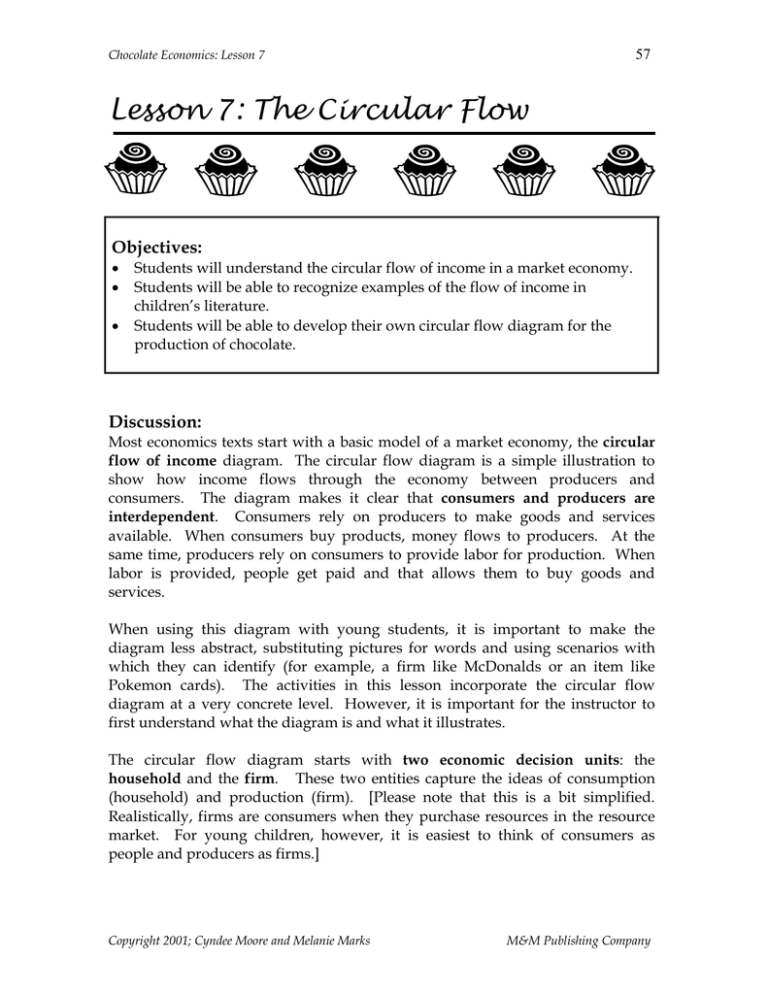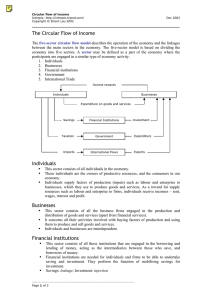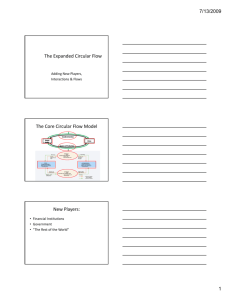Circular Flow of Income: Economics Lesson for Kids
advertisement

57 Chocolate Economics: Lesson 7 Lesson 7: The Circular Flow Objectives: • • • Students will understand the circular flow of income in a market economy. Students will be able to recognize examples of the flow of income in children’s literature. Students will be able to develop their own circular flow diagram for the production of chocolate. Discussion: Most economics texts start with a basic model of a market economy, the circular flow of income diagram. The circular flow diagram is a simple illustration to show how income flows through the economy between producers and consumers. The diagram makes it clear that consumers and producers are interdependent. Consumers rely on producers to make goods and services available. When consumers buy products, money flows to producers. At the same time, producers rely on consumers to provide labor for production. When labor is provided, people get paid and that allows them to buy goods and services. When using this diagram with young students, it is important to make the diagram less abstract, substituting pictures for words and using scenarios with which they can identify (for example, a firm like McDonalds or an item like Pokemon cards). The activities in this lesson incorporate the circular flow diagram at a very concrete level. However, it is important for the instructor to first understand what the diagram is and what it illustrates. The circular flow diagram starts with two economic decision units: the household and the firm. These two entities capture the ideas of consumption (household) and production (firm). [Please note that this is a bit simplified. Realistically, firms are consumers when they purchase resources in the resource market. For young children, however, it is easiest to think of consumers as people and producers as firms.] Copyright 2001; Cyndee Moore and Melanie Marks M&M Publishing Company Chocolate Economics: Lesson 7 58 The diagram goes on to illustrate the flow of money between the two sectors of the economy. Consumers buy goods and services from firms, but firms pay people for their labor. This exchange of money takes place in two different markets: the resource market and the output market (also referred to as the market for goods and services). The resource market is where firms buy the materials and labor that they need to produce their product. A firm that makes books would need to buy paper and ink, machines to do the printing, and labor to run the machines. The firm then converts these resources into goods that they sell in the output market. Households, on the other hand, are also involved in these two markets. Households provide labor to firms in the resource market. When we go to work in the morning, we are participating in the labor market. We earn money from the firms and this allows us to buy goods and services in the output market. Copyright 2001; Cyndee Moore and Melanie Marks M&M Publishing Company 59 Chocolate Economics: Lesson 7 From the firm’s perspective, the circular flow involves: 1) Purchasing resources in the resource market, 2) Using the resources to produce a good or service, 3) Selling the item to others in the output market. This is illustrated as follows: $$$$ $$$$ Copyright 2001; Cyndee Moore and Melanie Marks M&M Publishing Company 60 Chocolate Economics: Lesson 7 From the consumer’s perspective, the circular flow involves: 1) Providing labor to firms through the resource market, in exchange for money, 2) Purchasing goods and services from firms in the output market. This can be seen as follows: $$$$ $$$$ Copyright 2001; Cyndee Moore and Melanie Marks M&M Publishing Company 61 Chocolate Economics: Lesson 7 When the two perspectives are combined, the diagram shows the flow of money to moving in a circle. Firms spend money on inputs they need for production, one of these needs being labor. Households sell labor to earn money and then they spend it on goods and services sold by firms. Resources Labor $$$$ Goods and Services $$$$ Copyright 2001; Cyndee Moore and Melanie Marks $$$$ Goods and Services $$$$ M&M Publishing Company







